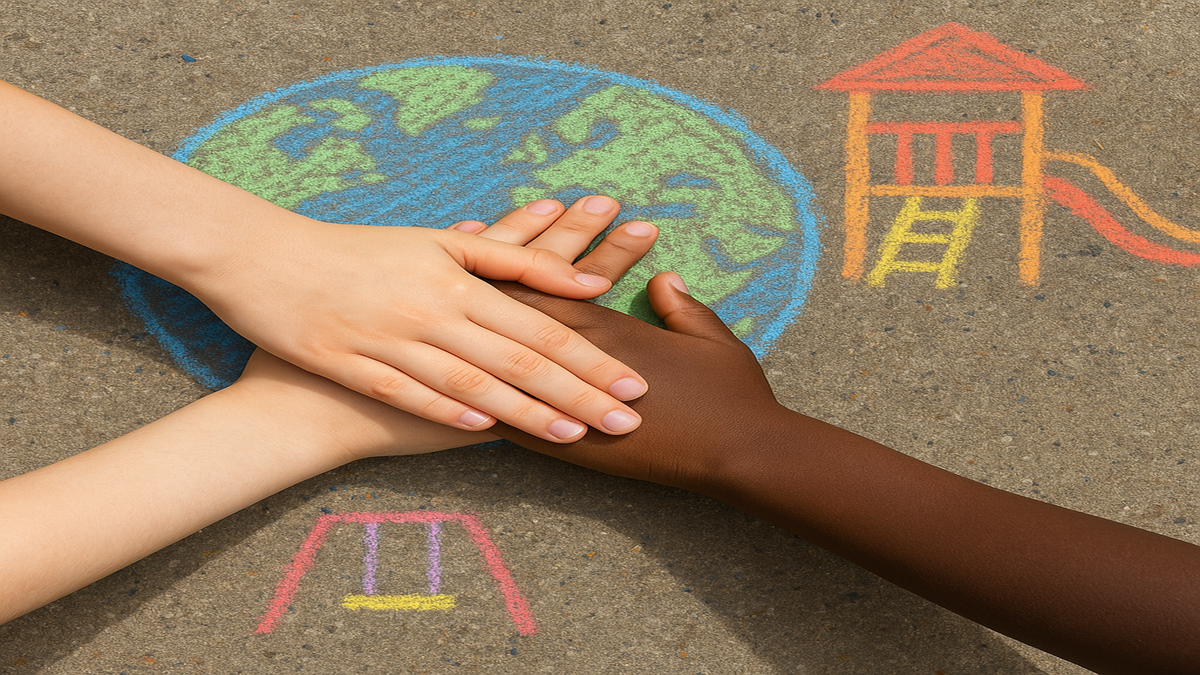Universal Language of Play: Helping Children Embrace Diversity and Inclusivity

My niece Aliyah, age five, invited her shy new classmate and neighbour, Miguel, to join a pretend “café” they were setting up under a tree. She didn’t pause to ask where he was from or whether he spoke English well. She just handed him a plastic cup and said, “You serve the lemonade!” Within minutes, they were in full swing, swapping roles, inventing menus, and giggling over spilled “drinks.”
During a recent trip to Jamaica, I watched as the neighbour’s yard came alive with laughter. Children of all shades and accents crowded around a large cardboard box. Some called it a pirate ship, others a taxi, and one boy insisted it was a rocket to the moon. No one stopped to argue over who was right. They just kept shifting, adapting, and sharing the story until everyone found a role.
These two scenes reminded me of the magic of play. Across cultures, languages, and backgrounds, children speak a universal dialect when they play together. In those moments, they transcend differences and begin to see one another as collaborators, not strangers. Play becomes a hopeful model for how early childhood experiences can help children internalize diversity and inclusivity in a way that few formal lessons ever could.
Play: A Universal Bridge
Play is fundamental to children’s social, cognitive, emotional, and physical development. The National Institute for Play reminds us that play “shapes the brain, opens the imagination, and invigorates the soul,” nurturing resilience, creativity, and connection.¹
Beyond these benefits, play also functions as a universal language. When children share blocks, draw together, or take on roles, they negotiate fairness, empathize with others, and practice inclusion, often more powerfully than any adult-led activity could achieve.
When Exclusion Speaks Louder Than Words
Yet, play can exclude as much as it includes. I once visited a preschool where one quiet girl, Keisha, always hung back at recess. The other children ran to the swings and slide, but no one invited her to join the excitement. It wasn’t bullying, just silence, but that silence carried a message: You don’t belong here.
Exclusion in play is often subtle, not active rejection, but the absence of an invitation. When we say play is universal, we must also admit that inclusivity in play spaces does not happen naturally. It must be intentionally cultivated. Just as we call everyone to the dinner table, we must invite every child to the play space: Come, join us. You matter here.
Research Says
“Inclusive Play: Defining Elements of Playful Teaching and Inclusive Practice” (MDPI) outlines how early childhood educators can scaffold inclusive play by balancing structure with freedom, using diverse communicative tools, and staying attuned to children’s emergent interests.²
The findings emphasize that inclusion is not an add-on; it is a mindset. Flexibility, responsiveness, and imaginative openness must become the heart of how we facilitate play. Children must be supported by teachers and parents to design play spaces that welcome everyone.
Strategies for Parents and Caregivers: Turning Play Toward Inclusion
Here are some simple, practical ways adults can use play to help children embrace diversity and inclusivity, wherever home may be, from Kingston, Jamaica, to Canada and beyond.
1. Offer Diverse Materials
Include dolls, figurines, and props that reflect varied ethnicities, abilities, family structures, and cultures. When children see both themselves and others represented, diversity becomes normalised.
2. Model Inclusive Language
Replace limiting phrases like “That’s a boy’s toy” with open ones such as “How can we all play together?” This encourages empathy and collaboration.
3. Ask Open Questions
After play, try asking: “Who else could have joined your game?” or “What would happen if a child in a wheelchair wanted to play too?” Simple reflections like these plant seeds of belonging.
4. Model Inclusive Behaviour
Let your children see you as an advocate for inclusivity. If your local park or school lacks accessible play areas, speak up, help build ramps, and invite others into your circle.
Planting Seeds of Belonging
The café that Aliyah and Miguel built under that tree was more than a game; it was an experiment in belonging. Two children from different backgrounds were testing what it means to include one another.
Play is also power. It’s how children practice justice, empathy, and community. When we guide them gently, they carry those lessons beyond the yard and into the wider world.
The next time you see children building a bus from cardboard boxes or organizing a ring game, don’t just smile and walk past. Step closer. Ask, “Who else can play too?” That one question might plant a lifelong seed of inclusivity.
Footnotes
- National Institute for Play. The Power of Play: Losing and Finding Ourselves Through Everyday Play (2024).
- Inclusive Play: Defining Elements of Playful Teaching and Inclusive Practice. MDPI Inclusive Play (2022–2023).
- Rebecca Horrace. “Learning Through Play: Nurturing Diverse and Inclusive Classrooms.” The Genius of Play (thegeniusofplay.org).